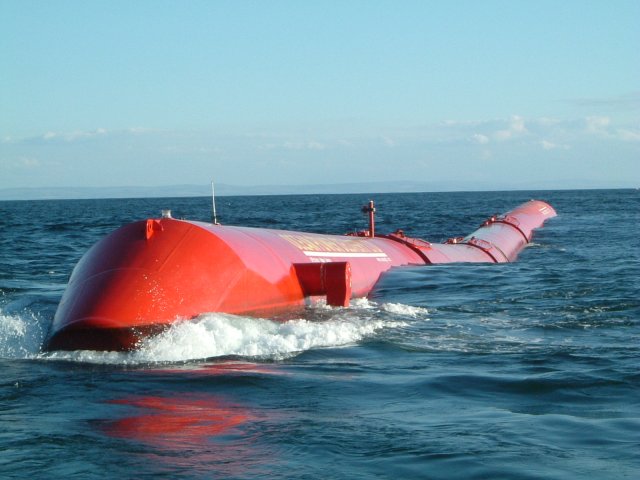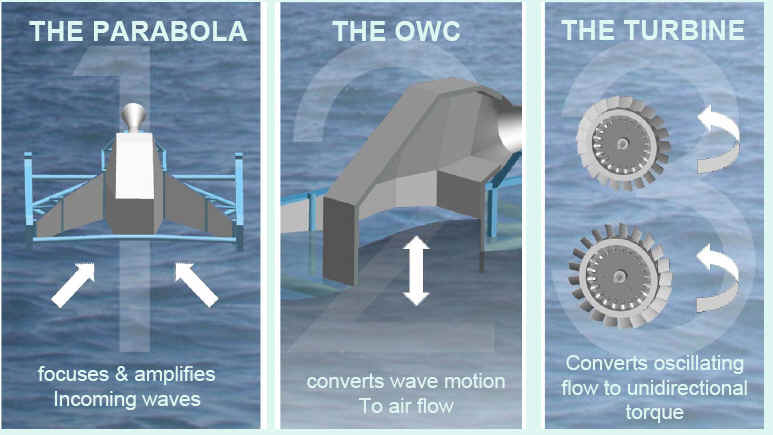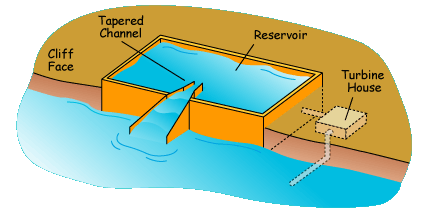|
Ocean Power
Tidal Energy
Some of the oldest ocean energy technologies use tidal power. All coastal areas
experience two high tides and two low tides over a period of slightly more than
24 hours. For those tidal differences to be harnessed into electricity, the
difference between high and low tides must be more than 16 feet (or at least 5
meters). However, there are only about 40 sites on Earth with tidal ranges of
this magnitude.
Tidal Energy Technologies
Tidal energy technologies include barrages or dams, tidal fences, and tidal
turbines.
Barrages or Dams
A barrage or dam is typically used to convert tidal energy into electricity by
forcing water through turbines, which activate a generator. Gates and turbines
are installed along the dam. When the tides produce an adequate difference in
the level of water on opposite sides of the dam, the gates are opened. The water
then flows through the turbines. The turbines turn an electric generator to
produce electricity.
Tidal Fences
Tidal fences look like giant turnstiles. They can reach across channels between
small islands or across straits between the mainland and an island. The
turnstiles spin via tidal currents typical of coastal waters. Some of these
currents run at 5–8 knots (5.6–9 miles per hour) and generate as much energy as
winds of much higher velocity. Because seawater has a much higher density than
air, ocean currents carry significantly more energy than air currents (wind).

Tidal Turbines
Tidal turbines look like wind turbines. They are arrayed underwater in rows, as
in some wind farms. The turbines function best where coastal currents run
between 3.6 and 4.9 knots (4 and 5.5 mph). In currents of that speed, a
49.2-foot (15-meter) diameter tidal turbine can generate as much energy as a
197-foot (60-meter) diameter wind turbine. Ideal locations for tidal turbine
farms are close to shore in water 65.5–98.5 feet (20–30 meters) deep.

Wave Energy
Wave energy technologies extract energy directly from surface waves or from
pressure fluctuations below the surface. Renewable energy analysts believe there
is enough energy in ocean waves to provide up to 2 terawatts of electricity. (A
terawatt is equal to a trillion watts.)
However, wave energy cannot be
harnessed everywhere. Wave power-rich areas of the world include the western
coasts of Scotland, northern Canada, southern Africa, and Australia as well as
the northeastern and northwestern coasts of the United States. In the Pacific
Northwest alone, it is feasible that wave energy could produce 40–70 kilowatts
(kW) per 3.3 feet (1 meter) of western coastline.
Wave Energy Technologies
Wave energy can be converted into electricity by offshore or onshore systems.

The Pelamis device is a semi-submerged, articulated structure, 120m long and
3.5m in diameter, that is composed of cylindrical sections linked by hinged
joints. The wave-induced motion of these joints is resisted by hydraulic rams,
which pump high-pressure fluid through hydraulic motors via smoothing
accumulators. The hydraulic motors drive electrical generators to produce
electricity. Power from all the joints is fed down a single umbilical cable to a
junction on the sea bed. Several devices can be connected together and linked to
shore through a single seabed cable. Depending on the wave resource, machines
will on average produce 25-40% of the full rated output.Source: Wind &
Hydropower Technologies Program, U.S. Department of Energy, Energy Efficiency
and Renewable Energy
Offshore Systems
Offshore systems are situated in deep water, typically of more than 131 feet (40
meters). Sophisticated mechanisms—such as the Salter Duck—use the bobbing motion
of the waves to power a pump that creates electricity. Other offshore devices
use hoses connected to floats that ride the waves. The rise and fall of the
float stretches and relaxes the hose, which pressurizes the water, which, in
turn, rotates a turbine.
Specially built seagoing vessels
can also capture the energy of offshore waves. These floating platforms create
electricity by funneling waves through internal turbines and then back into the
sea.
Onshore Systems
Built along shorelines, onshore wave power systems extract the energy of
breaking waves. Onshore system technologies include:
•Oscillating Water Columns:
Oscillating water columns consist of a partially submerged concrete or steel
structure that has an opening to the sea below the waterline. It encloses a
column of air above a column of water. As waves enter the air column, they cause
the water column to rise and fall. This alternately compresses and depressurizes
the air column. As the wave retreats, the air is drawn back through the turbine
as a result of the reduced air pressure on the ocean side of the turbine.


•Tapchans: Tapchans, or tapered channel systems, consist of a tapered channel
that feeds into a reservoir constructed on cliffs above sea level. The narrowing
of the channel causes the waves to increase in height as they move toward the
cliff face. The waves spill over the walls of the channel into the reservoir,
and the stored water is then fed through a turbine.

•Pendulor Devices: Pendulor wave-power devices consist of a rectangular box that
is open to the sea at one end. A flap is hinged over the opening, and the action
of the waves causes the flap to swing back and forth. The motion powers a
hydraulic pump and a generator.
credit: NOAA, U.S. DOE,
American Wind Energy Association, Bureau of Land Management, Sandia
National Labooratory Australian CRC for Renewable Energy,Fujista
|








